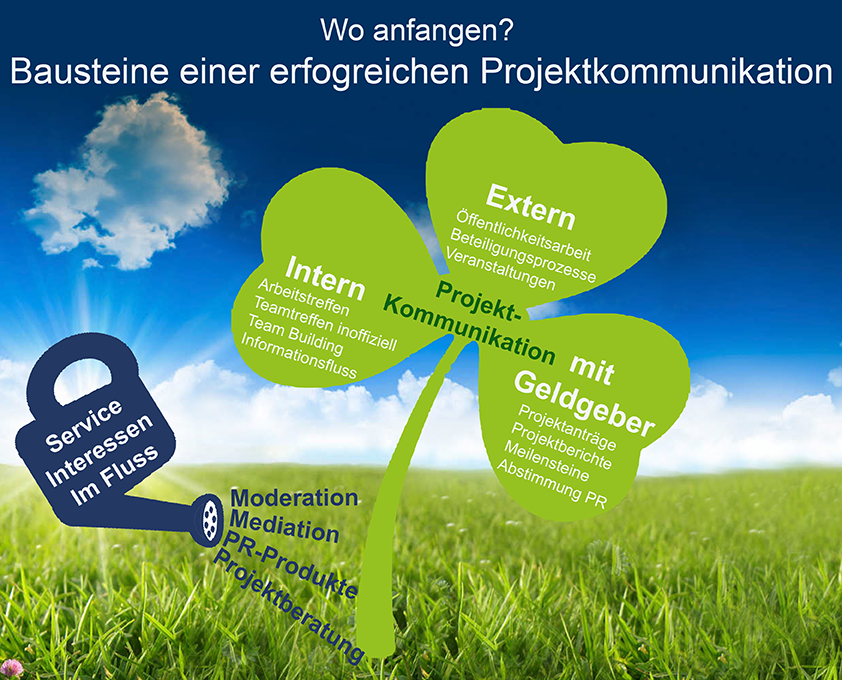“Get going!“ This is the main message accompanying the start of most new projects. The positive excitement goes hand in hand with a bit of unease regarding the upcoming work.
Your roadmap for unknown territory
Most project management challenges are (hidden) tasks related to communication. Our experience shows: Identifying these challenges helps project stakeholders to address and deal with them. This blog post provides an overview of the key elements of successful project communication. Upcoming blog posts will focus on the details of some of these key elements. In this English version of our blog, we will mainly be focussing on aspects that are relevant to international projects.
1. Internal project communication
Problems start at the top. Or, to put it into a more positive sentence: Only if your team feels really involved will it be possible to make use of their full potential for your project. This is what internal communication is all about. It includes four aspects:
1.1 Productive meetings
Who is doing what, why, how, and (until) when? Clarifying tasks, giving mutual updates, staying in touch, exchanging thoughts on challenges, feeling the mood – these elements are key to successful projects, and regular meetings can help to facilitate them all. After the kick-off, one “jour fixe” per month (at the start of the project, it could also be more often) can be a good thing to start with. A short agenda, shared with participants beforehand, and a clearly defined timeframe are the minimum requirements for effective meetings. This also applies to telephone conferences!
During such meetings, chairing and time keeping can be rotating tasks, so that everyone gets the opportunity to freely engage in the discussion at one point or another. In international projects, regular telephone conferences of a core group (each month) or partner meetings (every six months) show very positive effects on the overall project performance. Highlight the uniting aspects of project work, so that all partners can join in with their particular point of view.
1.2 Informal interaction
It is no secret: Coffee corners, water tanks, and smoking areas are hideouts with a high flow of information, and they are often the birthplaces of great ideas, too. But don’t worry, you do not have to develop an addiction to coffee, beer, and cigarettes. You can simply create and provide spaces for an informal social exchange. A joint lunch break, a short walk after lunch or a nice cup of tea in the morning will do the trick. At international meetings, an excursion is an easy way to provide such a space, and, at the same time, you can learn more about the context your partner operates in!
1.3 Team building
A shared task / activity without a direct connection to your project may highlight unexpected qualities in your colleagues, and it could also contribute to good team work. However, as a prerequisite, all colleagues have to join in voluntarily. There are many different settings – and special team building exercises are not a “must”. The creation of spaces for social interaction as laid out above can be a good alternative for projects with limited resources.
1.4 Easy sharing of files and information
A shared space for data storage used by all project members is worth its bytes in gold! However, different projects often use different system, and in projects with partners from around the globe, file sharing can become a tiring exercise. It does help if the project management team offers and continuously uses one system. Many organizations put a strict limit on attachment sizes and offer cloud-based sharing systems instead. Keep an eye on data protection requirements! For European projects, a European server is a good place to start. If confidentiality requirements allow for it, easy access can be achieved by using one shared password for read only / download access.
External communication: stakeholder involvement & pr
“Talk about your good deeds – and involve the relevant stakeholders as early as possible!” – Most funding bodies require you to share and publish your results, and they also want you to talk to relevant stakeholders at an earlier stage of your work. The idea is that, at an early stage, the exchange with stakeholders might not only help you to adapt your plans, but also gets them excited about (interesting) results that will come later. This can give you a good edge in the race for attention. However, choose the appropriate communication channels for your target group, and make sure you do not frustrate them. For example, do not actively involve your stakeholders in questioning your project targets if you have no intention of adapting them.
2.1 PR
Public relation work can be one-way or interactive:
2.1.1 One-way PR: provision of information
Recipients are informed about your project topics and results via leaflets and newspaper articles, in TV reports and in videos, but they cannot interact with you and are not invited to provide their feedback.
2.1.2 Interactive PR
People often want more than just be flooded with pieces of information. They want to comment, to be visible, and to get into touch with those leading the discussion. A social media approach is the best way to cater to these needs. But there are also ways to get into a dialogue with “reluctant web users”.
2.2 Activ involvement
The highest form of art in external project communication is the active involvement of people in participatory processes (e.g. citizen forums or stakeholder workshops with consultations). These approaches are useful if you need support for and wide-ranging acceptance of your project, or if you need “swarm intelligence”, or if you want to include other bits of your stakeholders’ knowledge. However, it is most vital to completely think those processes through: What do you want to do with the results? What kind of outcome do you want? Who do you want to involve? Experience shows that participatory processes are often only planned half-heartedly. This does not only use up much of the project’s positive potential, it often can also create frustration among both stakeholders and project partners, thus even having a negative impact. This is why our core services are related to active involvement. Upcoming blog posts will address them once in a while.
2.3 Conferences and networking meetings (for expert audiences)
Conferences and networking meetings are good formats to combine one-way communication (presentations and posters) with interaction (Q&A, discussions, speed dating). However, the main focus of these types of events still is on the provision of information, and less on interaction.
Communication with funding partners
Often neglected, this is a crucial point of successful project management: Good communication with the team of your funding body will help you tremendously, especially when you have to deal with unexpected problems, or when you need to adjust your project’s plan and budget. Of course, it might also have a positive impact on follow-up projects. So keep your contact person at the funding body well informed, even if no report is due right now – tell them about interesting news, and if you are writing a proposal, do not hesitate to ask for their feedback in an early phase. Funding bodies usually appreciate the chance to help with project ideas, because this way, the projects will better suit their programme later.
Full steam ahead?
Do you feel a bit overwhelmed by all the communication tasks lying ahead? Don’t worry. Good captains take a crew with them to make their journey a safe one. You can get support for your project, too. Ideally, some of your project proposal’s budget is already dedicated to this. But even if this is not the case, there usually is some flexibility that allows you to delegate some parts of the job to external experts. We can help you find it.
At your service: How can we support you?
We keep an eye on all aspects of project communication. For your external and internal communication, we offer: strategy development and implementation, moderation, mediation, event planning, set-up and implementation of public & stakeholder involvement processes. Of course, we are also happy to support you when developing your project idea and writing proposals for third party funding. Find out more!

